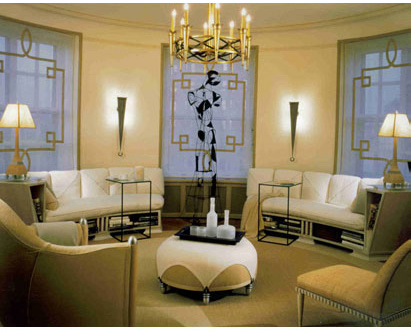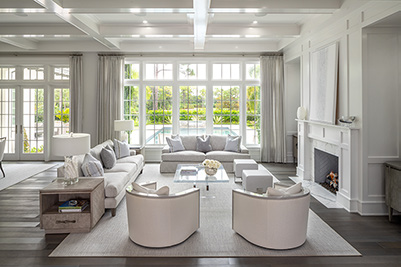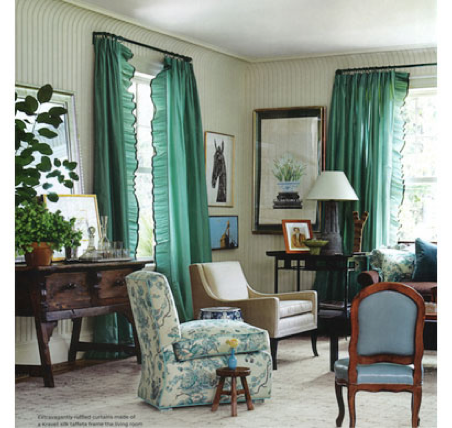
Do the windows in your newly painted or designed living room need a makeover? Did you find a gorgeous set of Federal chairs at the flea market that need re-upholstering? Would you like to transform your aging—yet amazingly comfortable—armchair into a spectacular piece that matches your sofa and decor? Or are you ready to buy a complete set of custom-upholstered furniture for your living room? Whether you are thinking about the design and construction of your piece or which fabric to choose, upholstery and window treatment experts are the professionals to call.
Many high-end upholsterers who do specialized work deal exclusively with the trade (decorators and architects). We have clearly noted these professionals in our reviews. These service providers primarily focus on custom work—creating a piece from scratch rather than reupholstering. In the case of window treatments, high-end specialists do custom work rather than installing materials from stock.
- What Type of Upholstery Service Do I Need?
- Know Your Upholstery Construction
- What to Look for in Quality Upholstery Work
- On Cost (Upholstery)
- Window Treatments
- Where Do I Start?
- Window Treatment Fabric and Construction
- On Cost (Window Treatment)
- Tips on Caring for Upholstered Furniture

Your three basic choices are custom upholstery, reupholstery and custom slipcovers. You may not need a completely new piece of furniture; depending on the condition of your frame and webbing, you may choose to reupholster or have custom-made slipcovers made as a less expensive alternative. An upholstery professional will be able to assist you in assessing the structure of your existing piece.
To help narrow down the service you need, determine how the furniture will be used. Is it a seating piece that is frequently used by the family and guests (and pets), or a more stylized piece that is located in a less frequently used space? If it will receive heavy use, you’ll choose springs and cushioning that will stand up to this treatment as well as a fabric that is durable and easy to clean.

Frames: The frame is the skeleton of your piece, determining the sturdiness as well as overall appearance of the object. The best frames are made of kiln-dried hardwood. Oak, maple and ash are the hardwoods of choice by professionals. Kiln drying removes moisture and sap from the wood which could cause the frame to warp or bend. When assembling the frame, the ideal method involves using dowels and cornerblocks. This is more costly than using nails and glue but will greatly increase the quality and add years to the life of your piece. Tacks are the preferred method for attaching fabric to the frame, although staple guns are sometimes used. Staple guns should not be used in constructing the frame, however.
Springs: The main function of springs is to support the furniture’s cushioning. The two basic spring systems for upholstered furniture are round coil springs and flat, s-shaped “no-sag” coils. Most traditional pieces use hand-tied steel spring coils, in which coils are tied by hand in six or eight places around the diameter of the spring. S-shaped or zig-zag coils are sometimes used for contemporary pieces and do not provide the same support as spring coils. S-shaped springs can become lumpy or uneven over time.
Cushions: These come in two types: attached and loose. In an attched construction, fiber-covered foam is placed over the spring system, then covered with fabric. Loose cushions resemble big pillows that are easily fluffed, moved or turned over to prevent signs of wear. Some pieces may also include semi-attached cushions which look much like removable cushions but are actually part of the piece. Both types of cushions can be filled with a wide variety of filling, from luxurious pure down and down blends to synthetic foam fill.
Down is the ultimate cushion filling and comes at a premium price. The typical down-feather blend consists of 80 percent down and 20 percent feathers. The biggest drawback of down or down-blend fill is the frequent need to fluff the cushions to keep the shape and comfort. Because of the high level of maintenance required and possible allergies to down, many consumers prefer to go with a combination of down and foam.
In very high-quality cushion construction, springs are individually wrapped, encased in foam, then covered in a down and feather mixture. This is all then encased in a muslin bag in order to contain the feathers before being covered with fabric. This combination provides firmness and will hold its shape much longer than a down-blend or all-foam cushion.
Fabrics: The possibilities are endless when choosing upholstery fabric. With so many options, you can narrow your search by exploring a few basic issues. Prices vary widely, from $10 to over $250 per yard. The most important issue is how the piece will be used. Do you need a super durable fabric that can withstand daily use? Or is it a not-to-be-touched showpiece that can be covered in a delicate silk? Some fabrics are simply stronger than others. Ease of cleaning should also be considered. Pieces in the TV room or children’s bedroom may attract more dirt; darker, more durable fabric that withstands frequent cleaning would be appropriate for this furniture. Upholsterers handle the issue of fabric in a variety of ways. Some have catalogs and swatches from which you can choose; others insist that you bring in your own fabric choices. This option is known in the trade as COM—customer’s own material. If you do not have the time or inclination to shop for your own fabric, make sure you choose an upholsterer who provides this service. Keep in mind that the ease or difficulty of working with a particular fabric will affect the price of the job.

When viewing the work of an upholstery professional in the showroom or someone’s home, keep the following points in mind:
Fabric patterns should match at all seams and should be centered or balanced on any cushions or surfaces. This can be particularly important with more intricate patterns.
Check to see if any of the seams pucker, such as those along the arm of a sofa or on the back of a club chair. Seams should be perfectly smooth.
Are the sofa skirts lined? Is the cushion of the slipper chair invisibly secured with clips, and is the welt or trim tightly stitched?

As with any specialized custom work, upholstery prices vary significantly. The more detailed and specialized, the more labor involved and the higher the price. If cost is an issue, you should determine what level of quality you need for the particular piece you are having made. A chair in your four-year-old’s room will probably not require the same quality of fabric or workmanship as a sofa in your living room where you entertain regularly. All the components discussed in the upholstery construction section above directly contribute to the cost. Knowing a little bit about the basic construction will help you understand the real difference between a $700 and $7,000 sofa and help you determine your specific needs.
From a simple minimalist panel to a layer-upon-layer, elaborate design, many elements come together to make a window treatment. Carefully selected shades, sheers, curtains and valances may be held together with various trims, chords, brackets and hardware—and possibly finished off with finials. Some upholstery and window treatment professionals also do hard window treatments, which include all types of shades, laminated shades (roller shades, covered in your choice of fabric) and blinds custom made in your choice of materials to coordinate with your curtains.
To help you decide upon the perfect window treatment for your room, many shops can do miracles with photos and magazine clippings. Once you’ve settled on a basic design (perhaps with the help of your decorator or examples from your upholsterer), you need to take some measurements. Most service providers will come to your home and measure the window as part of their consultation. Some charge a fee to take measurements, others apply this charge once you place the actual order. Others do not charge at all. Ask the window treatment professional about his policy before setting up the in-home consultation.
Letting a professional do the measuring is preferred because there are many factors involved. Most treatments, for example, take up wall space as well as cover your window, and your window treatment specialist will know what to measure for in the entire room. Will you have finials that take up space on each side of the window? Will your drapes open from the center and be secured on each side with hardware? All of these factors will need to be considered when measuring and developing the final plans for your window treatments.
As with custom furniture upholstery, fabric choices for window treatments are endless. Your design and the room where the drapes are being placed are two issues that will dictate which fabric you choose. Again, as with upholsterers, some window treatment shops will provide you with a choice of fabrics and others will require you to provide your own. Ask how the service provider operates and if there will be any additional charges if you choose to provide your own fabric. In addition to selecting a fabric for color, texture and print, consider how easy it will be to clean. Curtains and window sills in the city are vulnerable to dust, dirt, grime and soot.
Most window treatments require more than one layer of fabric. To give each curtain volume, it is lined and interlined. The interlining is commonly made of flannel, which not only provides heft and a bit of structure, but also a measure of soundproofing. This three-layer construction will provide you with material that will drape very nicely. If you are looking for something a bit more simple, a two-layer construction with a single lining will be sufficient.
Your window treatment cost will be determined by some or all of the following: measurement fee, installation fee (will vary according to the complexity of the job), labor charges, fee for providing your own material or cost of fabric from the shop. Two of the most significant factors in the price will be the fabric, which varies widely in price, and the complexity of the construction of the draperies. A three-layer construction, with lining and interlining, will be more expensive to produce than a single- or two-layer construction.
- Ask your upholsterer or fabric supplier exactly how to care for your new fabric.
- Vacuum often to get rid of dirt particles that cause abrasion and wear.
- Don’t allow pets on furniture—their body oils rub off on the fabric and are tough to remove.
- Protect fabric-covered pieces from the sun to avoid fading and deterioration.
- Turn over loose cushions every week for even wear.
- Beware of sitting on upholstered furniture while wearing blue jeans or other fabric-dyed clothing—the color may “bleed” onto the fabric.
- Do not set newspapers or magazines onto upholstered furniture, as the ink may also bleed onto the fabric.
- Regular professional cleaning is ideal.
- Immediately after the spill, blot (don’t rub) the area with a clean cloth. Dried spills are more difficult to remove.
- Carefully follow the instructions on the cleaning product (don’t wing it).
- If you can use water for cleaning, be sure it is distilled.
- Choose a hidden area on the fabric to pretest the cleaner for color fastness before applying to the spill.
- Avoid making a small spill larger by working lightly, blotting out from the center. To avoid rings, “feather” the edges by dampening the edge of the spill irregularly and blotting quickly.
- Using a small fan or blow dryer (on low setting), quickly dry the cleaned area.